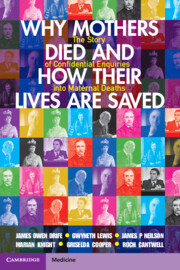 Why Mothers Died and How their Lives are Saved
Why Mothers Died and How their Lives are Saved Published online by Cambridge University Press: 05 April 2023
In the nineteenth century abortion was widely available in Britain but abortionists risked life imprisonment. In 1927 The Lancet suggested that doctors should be allowed to act in good faith and in 1929 abortion to save a woman’s life became legal. Calls for change grew and the Abortion Law Reform Association was formed in 1936. In 1937 an investigation found that abortion caused 14% of all puerperal deaths. In 1938 a leading gynaecologist, Aleck Bourne, was acquitted after performing an abortion on a 14-year-old rape victim. In 1939 a committee recommended that grounds should include serious risk to health. War changed Parliament’s priorities and in 1952-4 abortion was the third commonest cause of maternal death: 80% of the women were married with children. Abortion was the leading cause in the 1960s, and, in 1967, after many failed attempts, Parliament passed the Abortion Act sponsored by David Steel, a young Liberal MP. The number of legal abortions rose to equal pre-1967 estimates and levelled off. By 1979 deaths from abortion – including those classed as spontaneous – had almost disappeared. Medical opinion was still split and NHS provision remained patchy for years.
To save this book to your Kindle, first ensure no-reply@cambridge.org is added to your Approved Personal Document E-mail List under your Personal Document Settings on the Manage Your Content and Devices page of your Amazon account. Then enter the ‘name’ part of your Kindle email address below. Find out more about saving to your Kindle.
Note you can select to save to either the @free.kindle.com or @kindle.com variations. ‘@free.kindle.com’ emails are free but can only be saved to your device when it is connected to wi-fi. ‘@kindle.com’ emails can be delivered even when you are not connected to wi-fi, but note that service fees apply.
Find out more about the Kindle Personal Document Service.
To save content items to your account, please confirm that you agree to abide by our usage policies. If this is the first time you use this feature, you will be asked to authorise Cambridge Core to connect with your account. Find out more about saving content to Dropbox.
To save content items to your account, please confirm that you agree to abide by our usage policies. If this is the first time you use this feature, you will be asked to authorise Cambridge Core to connect with your account. Find out more about saving content to Google Drive.